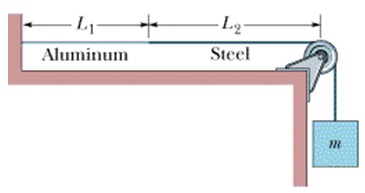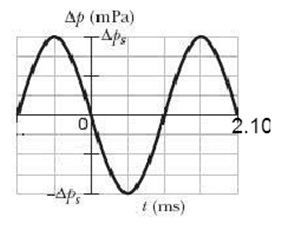Assignment:
1. In the figure, an aluminum wire, of length L1 = 35.3 cm, cross-sectional area 1.92 × 10-2 cm2, and density 2.60 g/cm3, is joined to a steel wire, of density 7.80 g/cm3 and the same cross-sectional area. The compound wire, loaded with a block of mass m = 14 kg, is arranged so that the distance L2 from the joint to the supporting pulley is 25.5 cm. Transverse waves are set up in the wire by using an external source of variable frequency; a node is located at the pulley.
(a) Find the lowest frequency that generates a standing wave having the joint as one of the nodes.
(b) How many nodes are observed at this frequency, including the end nodes?

2. In a demonstration, a 1.9 kg horizontal rope is fixed in place at its two ends (x = 0 and x = 3.6 m) and made to oscillate up and down in the fundamental mode, at frequency 5.2 Hz. At t = 0, the point at x = 1.8 m has zero displacement and is moving upward in the positive direction of a y axis with a transverse velocity of 5.4 m/s. What are (a) the amplitude of the motion of that point and (b) the tension in the rope? (c) Write the standing wave equation for the fundamental mode. Round numeric coefficients to three significant digits.
3. The figure shows the output from a pressure monitor mounted at a point along the path taken by a sound wave of a single frequency traveling at 345 m/s through air with a uniform density of 1.41 kg/m3. The vertical axis scale is set by Δps = 4.40 mPa. If the displacement function of the wave is written as s(x, t) = smcos(kx - ωt), what are (a) sm, (b) k, and (c) ω? The air is then cooled so that its density is 2.25 kg/m3 and the speed of a sound wave through it is 321 m/s. The sound source again emits the sound wave at the same frequency and same pressure amplitude. What now are (d) sm, (e) k, and (f) ω?
